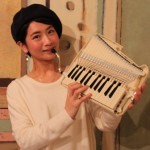Tokai Gakki PC-1
Tagged: PC-1, Tokai Gakki
- This topic has 14 replies, 3 voices, and was last updated 3 years, 11 months ago by
 Alan Brinton.
Alan Brinton.
-
AuthorPosts
-
October 30, 2015 at 2:51 am #6187
 Alan BrintonParticipant
Alan BrintonParticipantMy best information on this model is that it was in production from 1961 to 1967. If this is correct, then The Tokai Gakki PC-1 was a first generation Japanese Keyboard Harmonica, introduced at roughly the same time as the first Yamaha and Suzuki keyboard harmonicas. Tokai Gakki developed and manufactured the first Yamahas, released in 1961 under both the Yamaha brand and the Tokai Gakki brand, which included at least the Pianica 32, probably the Pianica 25, and possibly the Pianica 22. Suzuki’s button Melodions were released in 1960, though probably only in small numbers to test the market. The Suzuki Super 34 Melodion was marketed in 1961. Tokai Gakki apparently also released the PC-1 in 1961, and it seems clearly to have been strongly influenced by Borel’s 1958 Clavietta. The PC-1 is atypical of early Japanese keyboard harmonicas. It has a laminated wooden soundboard and is mechanically more sophisticated than subsequent melodicas and keyboard harmonicas.
Here now are photos of a PC-1 I acquired recently. Its reeds are in mint condition. It shows no signs of having been used much, except that some screws are missing, which suggests that it has been taken apart and perhaps tuned. Here are photos.
October 30, 2015 at 7:13 am #6190 DarenKeymaster
DarenKeymasterThanks for the photos and info Alan. I’ve just bought one!
October 30, 2015 at 5:25 pm #6192 Alan BrintonParticipant
Alan BrintonParticipantGreat! Now we’ll be able to compare notes. These are not hard to find at a reasonable price. Mine is in near-new condition and came in the original cardboard box (the style of which confirms a 1960s dating — very similar to the box of the Yamaha Pianica 32A). However, one note was sounding all the time because the little gold colored gizmo, which serves as the air pad for each white key reed, had come off. Another one, at the low G, has since fallen off. These screw (or snap?) into the bottom of very back end of the white keys. When the key is depressed, the pad lifts and allows air to flow out of a slot or “trench” for the individual reed. I’m guessing that this arrangement isolates each reed somewhat more so than on a typical melodica — so it may be that the effect is similar to what you get with individually mounted reeds — just a guess. I will now see whether these two pads can be remounted without removing the keys, which could be problematic. Each key has its own spring — I think “lever spring” might be the right word here — mounted on its bottom. This PC-1 will not play until these pads are replaced. The face of the pad fixture is as you see it in the above photo. It may have been coated with some substance or had some material glued on — you can see in the photo as much as I can about that. Here are some more close-up photos:




 October 30, 2015 at 10:36 pm #6195
October 30, 2015 at 10:36 pm #6195 Alan BrintonParticipant
Alan BrintonParticipantTHE REST OF THE STORY
Well, I discovered screws attaching the keyboard to the soundboard and decided to take the plunge. Whether I’ll be able to do what needs to be done and get this reassembled remains to be seen. But it’s clear that some restoration is needed simply as a result of the ravages of time. There’s no evidence whatever from the reeds or reed plates that this Pianica has been used.
For your information, Daren, there are five screws that affix the keyboard to the soundboard. The fifth by low G is obscured and has to be removed with a very narrow screwdriver. In addition to screws, there are multiple tiny nails, which should slide back into their holes, though getting them positioned for that may be tricky. There are two strips: one with the holes for the key pads, made of some kind of plastic/rubber. It’s fine. The other of some soft now-crumbled material, which should be easy to replace with leather lace. The pads for the black keys are plastic. One came off and looks like it can be glued back on. The pads for the white keys are those metal gizmos, which also look like they can be glued back on. They are of two sizes, larger on the low keys. When the keyboard is removed from the soundboard, whatever is loose falls out (as did two gizmos while it was still intact); so it would be very easy to loose tiny irreplaceable parts.
October 30, 2015 at 10:43 pm #6196 Alan BrintonParticipantNovember 9, 2015 at 1:19 am #6227
Alan BrintonParticipantNovember 9, 2015 at 1:19 am #6227 pianonymousParticipant
pianonymousParticipantHi,Alan
I’m always really enjoying your review.
I have the same model. I got it from my friend, and he buy it only 5$ by auction…
however I couldn’t open the Air Chamber because it glued very hard… How did you peel off the rid of Air Chamber?
Peeled off forcibly?November 9, 2015 at 1:37 am #6229 Alan BrintonParticipantNovember 9, 2015 at 8:17 am #6230
Alan BrintonParticipantNovember 9, 2015 at 8:17 am #6230 pianonymousParticipant
pianonymousParticipantAlan, thanks.
I could find the same parts, and it can take off easily.
http://cdn-ak.f.st-hatena.com/images/fotolife/p/pianonymous404/20150630/20150630182841.jpg
But the rid of Chamber and Wooden body are stuck..
I’ll try the other way. Thanks:)November 9, 2015 at 8:49 am #6231 Alan BrintonParticipant
Alan BrintonParticipantI removed the black lid by using a small screwdriver to pry it loose in the corners and along the edges. It seemed stuck, but it loosened gradually and then I slowly lifted it up from the mouthpiece end, which provides leverage. It was not glued and removing it caused no damage. The rim of the black metal cover has to be separated from the white gasket. It sticks to the white gasket, but the gasket is hard and was not damaged by gradually forcing those two pieces apart. You have to be careful not to damage the gasket with the screwdriver or other tool. I would say Yes, that the black cover has to be peeled off forcefully, but slowly and gradually. Jerking it off will probably damage the white gasket.
Separation of the keyboard from the wooden body was much more difficult and should be avoided if possible, because that is when things start to fall apart, and because of all the tiny nails that help hold it together. I have to glue key pads back on and figure out how to get all those nails in place. I’m not sure whether I can get it all back together. I am waiting until I have more time to try. I made the decision to do whatever was necessary to get it apart since there was no other way to replace a key pad. And I wanted to see what was inside regardless of the consequences.
April 19, 2018 at 5:57 am #9809 pianonymousParticipant
pianonymousParticipantRecently I have not logged in to my oasis for a long time.
The level of debate in Japan is so low, so that I get excited and feel happy when I come here..End of the March, I went to Hamamatsu-city(It is known as a musical instrument town with Yamaha and Suzuki), then I visited Tokai-gakki office.
http://www1.odn.ne.jp/tokaigakki/
https://goo.gl/maps/aNgqg4Ao8Q82I got those Development documents papers from Tokai’s president.
Thats Old paper, but the condition is good.
https://drive.google.com/file/d/1FJbSlnKIGff_Z1Wpmyv-IYLiyT0zi6Cs/view?usp=sharing
Developers of PC-1 was “Mr.Saigoh” and “Mr.Ohki”. (I checked the Seal)On Next September, I’ll visit Hamamatsu-city again, Then I try to take PDF of those documents.
So plz Look forward to it, thanks.April 19, 2018 at 1:59 pm #9810 Alan BrintonParticipant
Alan BrintonParticipantGood to see you back here, Akeo. Welcome home. On another topic, have you played the new wooden Suzuki W-37? You have such extensive knowledge of present and past keyboard harmonicas that I’m enthusiastoc about knowing what you think of it.
April 19, 2018 at 2:32 pm #9811 pianonymousParticipant
pianonymousParticipantYes i have one. Now I’m not getting along with Suzuki, so they dont give it for me, however my friend buy and give it for me. okay, I’ll try to make review of W-37 on another topic thread.
April 19, 2018 at 3:36 pm #9812 Alan BrintonParticipant
Alan BrintonParticipantWe should all have such a friend!
April 20, 2018 at 11:01 am #9813 DarenKeymaster
DarenKeymasterI’d love to see a review of the W-37 as well!
May 11, 2020 at 5:19 pm #11270 Alan BrintonParticipant
Alan BrintonParticipantDoes anyone have anything new to report on the Tokai Gakki PC-1? I was never able to get my PC-1 back together and in playable condition. Its design was innovative and ingenious, and it’s a beautiful instrument. But I think it was too fragile and unstable and by design and not suited to automated mass production. The PC-1 has more of the character of a hand crafted instrument. Furthermore, although Tokai Gakki experimented with a few of its features in some other early Yamaha Pianicas, the PC-1 ended up having almost no discernible influence on the basic Yamaha design (of the P-25, 32 and 37) that prevailed and is manifested in the current P-25F, P-32D/E, and P-37D. So in terms of engineering and visual aesthetic, the PC-1 is of great interest; but in terms of historical influence it’s an anomaly.
The situation is different, it seems to me, with more recent innovative designs, even if they are not well suited to mass production. More recent innovative designs are, to some extent, being put on display in musical performances and having their design and development processes chronicled (here!).
-
AuthorPosts
- You must be logged in to reply to this topic.
























